Grape seed extract (GSE) is derived from the ground seeds of red wine grapes. Grape seed extract is especially rich in a very strong flavonoid called OPCs (Oligomeric Proanthocyanidins). When taken with bioflavonoids and OPC the life of vitamin C is greatly extended.
Grape Seed Pharmacological Effects and Benefits
Polyphenols in grape seed extract are primarily flavonoids, including gallic acid, the monomeric flavan-3-ols catechin, epicatechin, gallocatechin, epigallocatechin, and epicatechin 3-O-gallate, and procyanidin dimers, trimers, and more highly polymerized procyanidins. Various researches have shown that proanthocyanidins help to protect the body from sun damage, to develop vision, to improve flexibility in joints, arteries, and body tissues such as the heart, and to increase blood circulation by strengthening capillaries, arteries, and veins.
Antioxidant Activity
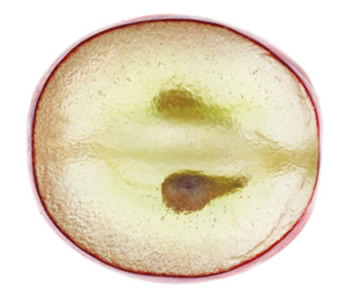 Free radicals have been implicated in over a hundred disease conditions in humans, including atherosclerosis, advancing age, ischemia and reperfusion injury of many organs, arthritis, Parkinson’s and Alzheimer disease, gastrointestinal dysfunctions, tumor promotion and carcinogenesis, and AIDS. Grape seed contains antioxidants, which help avoid cell damage caused by free radicals. In lab experiments, researchers have showed that grape seed can help fight free radicals.
Free radicals have been implicated in over a hundred disease conditions in humans, including atherosclerosis, advancing age, ischemia and reperfusion injury of many organs, arthritis, Parkinson’s and Alzheimer disease, gastrointestinal dysfunctions, tumor promotion and carcinogenesis, and AIDS. Grape seed contains antioxidants, which help avoid cell damage caused by free radicals. In lab experiments, researchers have showed that grape seed can help fight free radicals.
The antioxidative effects of grape seed extracts are found to be much stronger than vitamin C and vitamin E. A study conducted in 2003, found grape seed extract “provides superior antioxidant efficacy as compared to vitamin C, vitamin E and Beta-carotene.” One of the most bioavailable and strong forms of antioxidant, oligomeric proanthocyanidin complexes appear to be synergistic with vitamins, and in especially they protect the free radical scavenging effect of vitamin C. An study, conducted by Boston University of Medicine and USANA Health Sciences, demonstrated that the combination of grape seed extract plus vitamin C improved antioxidant status and vascular function in people with clinically proven cardiovascular disease.
Circulatory System
Grape seed promotes a healthful circulatory system by strengthening capillary walls and reducing leakage. Oligomeric proanthocyanidin complexes (OPCs) avoid capillary leakage in the legs, eyes and skin reducing fluid retention. In a double-blind study, a group of elderly participants with either spontaneous or drug-induced low capillary resistance were treated with 100-150 mg OPCs from GSE (grape seed extract) per day or placebo. 53% of patients in the treated group showed noticeable improvement in capillary resistance after 2 weeks. All patients in this group reached the maximum attainable result after 3 weeks.
Chronic Venous Insufficiency
Grape seed extract (GSE) strengthens weak and swollen blood vessels in the legs. Several studies have shown that oligomeric proanthocyanidin complexes from grape seed can lessen symptoms. In a double-blind study, 71 participant with peripheral venous insufficiency received 300 milligrams OPCs from grape seed per day. A important decrease in functional symptomatology was observed in 75 % of the treated patients compared to 41 % of the patients given a placebo.
Edema
Breast cancer surgery frequently leads to swelling of the arm. In a placebo-controlled study of 63 female breast cancer patients, postsurgical edema of the upper extremities was tested using 300 milligrams per day OPCs in the treated group for 6 months. At 6 months the OPC-treated group’s functional score was important improved. In especially there was a disappearance of pain in 59 % of the treated patients compared to 13 % taking the placebo. Another double-blind, placebo-controlled study of 32 participant who had received facial surgery, edema disappeared much faster in the group treated with grape seed OPCs.
Eye Diseases
Grape seed extract (GSE) improves blood flow in the eye’s tiny vessels, where some eye diseases can cause blockages and impairments that result in vision damage. Grape seed often recommended to combat macular degeneration, cataracts, and eye strain. Researches have shown that 300 mg daily reduces eye strain from prolonged computer use in 60 days. Also researches have shown that GSE may slow macular degeneration, improve vision stressed by computer screens or glare, and lessen myopia.
Dental Health
GSE helped avoid cavity formation and promoted remineralization of teeth in a laboratory study reported in the July 2012 edition of the Journal of Contemporary Dental Practice. In a study new performed at the “University at Buffalo’s Periodontal Research Center“, researchers demonstrated that smokers who took a supplement containing vitamin C, vitamin E and grape seed extract were able to improve their response to gum disease therapy.
High Blood Pressure
The antioxidants in grape seed extract have a protective effect on blood vessels, which can help avoid high blood pressure. A study published in the Dec 2009 edition of the journal Metabolism reported blood pressure-lowering positive effects of both 150 mg and 300 mg per day for 4 weeks.
Heart
Grape seed helps improve cardiovascular health. Japanese scientists found that proanthocyanidin was able to inhibit thrombus formation in the carotid artery. In a study reported in the Feb 2003 edition of Mutation Research found that grape seed extract improved cardiac function including ventricular function, reduced myocardial infarct size, reduced ventricular fibrillation and tachycardia, as indicated by reduction levels of homocysteine.
Chinese scientists proved that grape seed extract directly boosted antioxidant activity in heart cells, ın turn protecting heart cells from free radical induced death. Dr. Kendall, (University of Birmingham), introduced findings from his clinical research using standardized grape seed extract. His study showed measurable changes in serum antioxidant activity in the patients receiving the extract, leading him to conclude antioxidants may play a role in sudden death prevention, referring to the fact that for many patients with coronary artery disease, sudden death may be the first and only indication of the disease.
Researches show that grape seed extract may have the ability to block PAF (platelet activating factor), thus lengthening the time it takes for the blood to form clots. The inhibitory effect of Oligomeric Proanthocyanidins on thromboxane biosynthesis may explain the platelet aggregation inhibiting activity. A study demonstrated that grape seed extract significantly reduced the platelet stickiness in male smokers. A new study of 38 smokers indicates that oligomeric proanthocyanidin may function as effectively as aspirin in keeping blood cells from sticking together and forming blood clots. In a study of 22 smokers found that 100 mg of OPCs had an equivalent blood thinning effect as 500 mg of aspirin.
Skin
Extreme sun exposure, especially to UV rays, has a host of unfavorable effects on skin and health in general. The sun light can kill 50% skin cells of human, oligomeric proanthocyanidin complexes functions strongly avoid 85% skin cells from this horrible damage. In a study published in “Molecular Nutrition and Food Research” June 2008, showed that the in vitro and in vivo studies of the potential protecting effect of grape seed extract (GSE) proanthocyanidins and the molecular mechanism for these effects in SKH-1 hairless mice produced a decreased UVB-induced skin tumor development in terms of tumor incidence, tumor multiplicity, and a reduce in the malignant transformation of papillomas to carcinomas.
Immune Function
Chemicals in grape seeds known as proanthocyanidins have strong antioxidant and immune-boosting activities. In lab experiments, proanthocyanidins increased the power of natural killer cells, enhanced the production of IL-2, and decreased production of IL-6. In experiment by Zhang et al in 2005 concluded that proanthocyanidins from GSE, in combination with doxorubicin, inhibited tumor-growth by a proposed enhancement of immune function, including lymphocyte stimulation. Oral administration of oligomeric proanthocyanidin complexes in an experimental model effectively increased natural killer cell cytotoxicity and modulated ex vivo levels of interleukin-1, interleukin-6, and interleukin-10 in immune-compromised animals.
Antiviral
Researches of grape seed extract indicate antiviral activity against HIV. According to a study reported in Biological Research in 2002, GSE has anti-HIV effects because it interferes with HIV receptors and co-receptors. A new study found that grape seed extract (GSE) could reduce the infectivity of Norovirus surrogates. “This provides evidence grape seed extract could effectively damage the (norovirus) capsid protein, which could reduce viral binding ability and infectivity accordingly,” according to the researchers. The research is reported in the Nov 2012 edition of “Applied and Environmental Microbiology”.
Anticancer
Grape seed extract has shown anticancer effect in studies using breast, stomach, colon, lung, skin and prostate cancer cell lines. 35,239 males were followed over 10 years since 2000 in the VITAL cohort study Men, with “high average use” over 10 years of an individual grape seed extract experienced a 62% reduced risk of prostate cancer compared to non-users.
In a lab experiment reported in 2004 in the journal Breast Cancer Research and Treatment, grape seed extract was effective in blocking division of breast cancer cells in culture, reducing their growth rate by up to 72%. A study reported in 2010 in “Pharmaceutical Research” found that GSE (grape seed extract) stopped tumor growth in mice after clinically induced exposure to UVB radiation.
An article reported on Dec 2012 in the journal “Cancer Letters” reveals a strong effect for grape seed extract against colorectal cancer in experiments involving cultured cancer cells. Colon and intestinal cancer was inhibited in mice fed 0.5 % GSE for 6 weeks, in a 2010 study published in the journal Neoplasia. At the end of the research, observed a 40 % lessen in the total number of intestinal polyps.
A study reported in the journal “Carcinogenesis” shows that in both cell lines and mouse models, grape seed extract kills head and neck squamous cell carcinoma cells, while leaving healthy cells unharmed. A study performed out by Maryam Asargi involving 830 people compared various combinations of vitamins like A, C, E and multivitamins. The group taking grape seed extract (GSE) had an 74 % decrease in squamous cell carcinoma.
In a study published in the March 2005 edition of the Chinese Medical Journal reported that GSE (grape seed extract) promotes the death of human acute myeloid leukemia cells in the lab. An extract from grape seeds effects laboratory leukemia cells to commit cell suicide, according to scientists from the University of Kentucky. In a study, administered varying concentrations of a commercially available grape seed extract (GSE) to leukemia cell cultures. Researchers found that higher doses of the extract resulted in 76% of the leukemia cells undergoing apoptosis within 24 hours following exposure, while healthy cells remained unharmed. “These results could have implications for the incorporation of agents such as grape seed extract into prevention or treatment of hematological malignancies and possibly other cancers,” Dr Xianglin Shi, explained. In a study reported by “Carcinogenesis”, Agarwal (investigator at the University of Colorado Cancer Center) explained that grape seed creates conditions that are unfavorable to cancer cell growth. The grape seed extract both damages cancer cells’ DNA and stops the pathways that allow cancer cell repair.
Dosage
Grape seed extract (GSE) should contain 90-95% OPC. GSE is used in capsules mostly containing 50 mg or 100 mg. Doses of between 100-300 mg/day have been used in studies and are prescribed in several European countries.
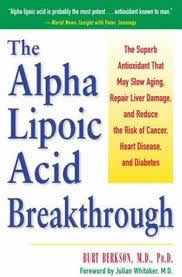 Alpha-Lipoic acid possesses strong antioxidant activity. The reduced form
Alpha-Lipoic acid possesses strong antioxidant activity. The reduced form 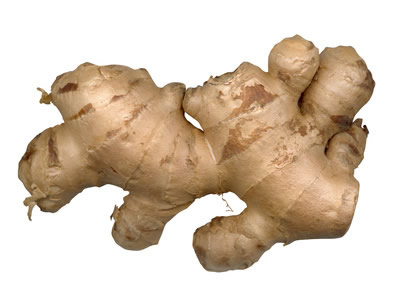 2000, the authors examined 6 study in which ginger was used to treat these problems. Researchers concluded that ginger root was more effective than a placebo in all cases and equally efficacious as anti-nausea medications in some situations. The antiemetic action of ginger root is attributed to its constituents,
2000, the authors examined 6 study in which ginger was used to treat these problems. Researchers concluded that ginger root was more effective than a placebo in all cases and equally efficacious as anti-nausea medications in some situations. The antiemetic action of ginger root is attributed to its constituents,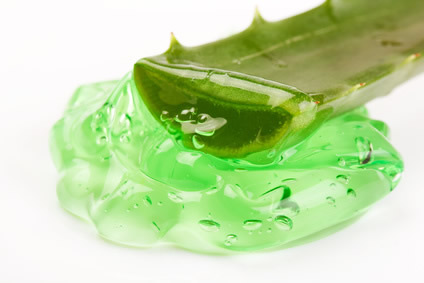 gastrointestinal tract. Studies have shown that aloe gel might be helpful in treating psoriasis, dandruff, seborrhea, and minor burns and skin abrasions, as well as radiation-induced skin injuries. The gel acquired from the leaf is useful for treating different skin diseases such as dermatitis, burns and other skin disorders.
gastrointestinal tract. Studies have shown that aloe gel might be helpful in treating psoriasis, dandruff, seborrhea, and minor burns and skin abrasions, as well as radiation-induced skin injuries. The gel acquired from the leaf is useful for treating different skin diseases such as dermatitis, burns and other skin disorders.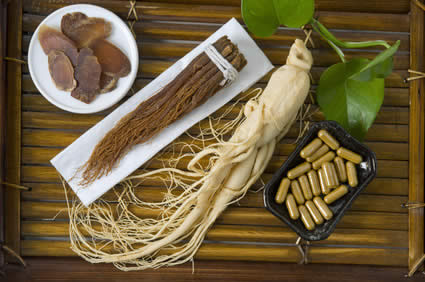 Panax ginseng is used for concentration, memory, depression, anxiety, loss of appetite, vomiting, physical stamina, chronic fatigue syndrome (CFS), fibromyalgia, diabetes, chronic obstructive pulmonary disease (COPD), premature ejaculation, and for boosting the immune system. Animal-based and in vitro studies show that Panax ginseng increases phagocytosis, natural killer cell activity, and the production of interferon. Panax ginseng is widely used as a adaptogen for fighting stress. There is some findings that it might work against stress by affecting the hypothalamic-pituitary-adrenal (HPA) axis. Helps the body modify adrenal and thyroid imbalances and “adapt” to stress.
Panax ginseng is used for concentration, memory, depression, anxiety, loss of appetite, vomiting, physical stamina, chronic fatigue syndrome (CFS), fibromyalgia, diabetes, chronic obstructive pulmonary disease (COPD), premature ejaculation, and for boosting the immune system. Animal-based and in vitro studies show that Panax ginseng increases phagocytosis, natural killer cell activity, and the production of interferon. Panax ginseng is widely used as a adaptogen for fighting stress. There is some findings that it might work against stress by affecting the hypothalamic-pituitary-adrenal (HPA) axis. Helps the body modify adrenal and thyroid imbalances and “adapt” to stress.